

Migrating from catkin_make — catkin_tools 0.0.0 documentation. When migrating from catkin_make to catkin build, the most common problems come from Catkin packages taking advantage of package cross-talk in the CMake configuration stage.
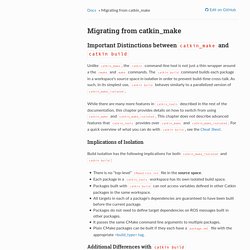
Many Catkin packages implicitly rely on other packages in a workspace to declare and find dependencies. When switching from catkin_make, users will often discover these bugs. Common Issues¶ Unknown CMake command “catkin_package”¶ If find_package(catkin REQUIRED ...) isn’t called, then the catkin_package() macro will not be available. Compilation Errors (Missing Headers)¶ Compilation errors can occur if required headers are not found. If your package includes headers from other libraries, make sure those libraries are found and those CMake variables are defined. How to structure a Python-based ROS package – Artificial Human Companions.
My apologies for the long wait since the last post.

I started a PhD in AI and Robotics at Cambridge University, which has been absorbing all my spare time. This post is actually quite old, but I never got around to publishing it. The good news is that I’ve learned a ton about robotics, biomimetics, ROS, MoveIt, deep learning, the Jetson TX1 and more, all of which I hope to share in due course. Rosintro. From Python to Catkin — catkin_pip 0.2.3 documentation.
Configuring rostest — catkin 0.6.19 documentation. Rostest is needed whenever unit tests require a roscore for running ROS nodes. package.xml The rostest package is needed at build time, because it defines the add_rostest() CMake command:

Personal Robotics Lab. Unit Testing Catkin can run C++ unit tests using the googletest library in C++ and the nosetest utility in Python.
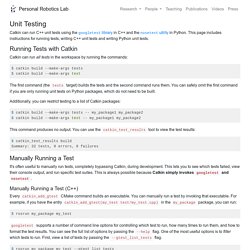
This page includes instructions for running tests, writing C++ unit tests and writing Python unit tests. Running Tests with Catkin Catkin can run all tests in the workspace by running the commands: catkin build --make-args tests catkin build --make-args test The first command (the tests target) builds the tests and the second command runs them. /Writing. Test nodes In order to create a rostest, you first need to write some test nodes.
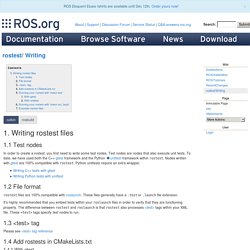
Test nodes are nodes that also execute unit tests. To date, we have used both the C++ gtest framework and the Python unittest framework within rostest. Nodes written with gtest are 100% compatible with rostest; Python unittests require an extra wrapper. File format. Statick: A static analysis framework - Quality Assurance - ROS. I would like to announce the release of Statick.

Statick is a plugin-based system to combine the results from a variety of static analysis and linting tools. Statick was developed by the U.S. Navy at the robotics branch of SSC Pacific and has been dedicated to the public domain. The main benefits of Statick are: manage flags for each tool in simple configuration filesprovides support for multiple levels of testingprovides consistent output of results from various toolsconfigurable settings to suppress false positivesignore specific files or file patterns. [SOLVED] Forward Kinematics: Get cartesian position from joint angles [closed] - ROS Answers: Open Source Q&A Forum. I am trying to find a method for calculating cartesian positions of specific joint angles.
![[SOLVED] Forward Kinematics: Get cartesian position from joint angles [closed] - ROS Answers: Open Source Q&A Forum](http://cdn.pearltrees.com/s/pic/th/kinematics-cartesian-position-203458212)
My goal is to be able to publish joint states and get cartesian positions back for each set of joint states, without running a robot simulation. I found this question: After looking into the joint_state_publisher and robot_state_publisher nodes and the /tf topic, I have come up with a somewhat convoluted method of achieving a forward kinematics solver. 1. My node publishes joint states for the robot, read from a text file 2. robot_state_publisher receives joint states and publishes transforms 3. Putting log messages from non-ROS code into ROS logging system - ROS Answers: Open Source Q&A Forum. I'm writing two new classes: A class that controls a motor control board (mcb) A ROS node that contains an object of the mcb class.
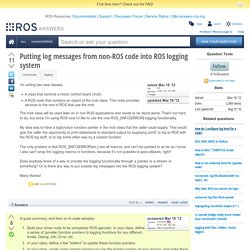
This node provides services to the rest of ROS that use the mcb. The mcb class will be used later on in non-ROS applications and needs to be stand alone. eTaSL Installation and Getting Started Guide — eTaSL 1.3 documentation. This documentation details installation for ROS CATKIN systems (required for e.g. eTaSL RTT).
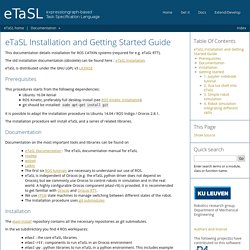
The old installation documentation (obsolete) can be found here : eTaSL Installation. eTaSL is distributed under the GNU LGPL v3 LICENSE Prerequisites This procedures starts from the following dependencies: Ubuntu 16.04 XenialROS Kinetic, preferably full desktop install (see ROS Kinetic installation)git should be installed: sudo apt-get install git. Windows Install Binary. This page explains how to install ROS 2 on Windows from a pre-built binary package.
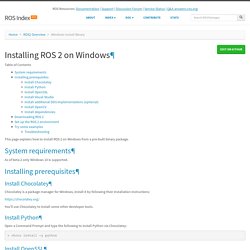
Installing prerequisites Install Chocolatey Chocolatey is a package manager for Windows, install it by following their installation instructions: You’ll use Chocolatey to install some other developer tools. Install Python Open a Command Prompt and type the following to install Python via Chocolatey: How to implement ros_control on a custom robot - Blog - Slate Robotics.
Introduction ROS has a ton of built-in packages to make it so that you don't have to do math. When I was first studying robotics, I was blown away by how much math was required to just control a two-wheel differential drive robot. Kinematics, PID control, and everything in-between meant that I spent a lot of time solving problems that were already solved. This is the beauty of ROS. Architecture and Software Design for a Service Robot in an Elderly-Care Scenario. 1. Introduction An aging society is widely considered to be one of the main socio-political challenges of the 21st century. Demographics, improved health care, increasing urbanization, and the trend towards smaller families imply that more and more elderly people are living alone. Recent data for Europe indicates that currently about 17.5% of the total population (88.5 million out of 505.7 million people in 2012) are aged 65+, but this percentage is expected to increase to 30% (164 million people) in 2050 [1].
The number of elderly people living alone varies between countries, and is as high as 67% for people aged 80+ in Scandinavia. Mobile personal service robots, capable of helping people in their daily housekeeping tasks, are one approach to tackling the problem (Figure 1). Taking ROS and Gazebo into healthcare — Open Robotics. As we shared in March, Open Robotics is now operating a research and development office in Singapore. This week, at the 2018 National Health IT Summit, Minister of Health Gan Kim Yong announced our initial project for the Singapore office: the Robotics Middleware Framework (RMF). After Mr. Gan's announcement, our own Brian Gerkey introduced the audience to Open Robotics and explained what we'll be building and why. As more robotics and automation technologies are introduced to healthcare, interoperability should be front and center for every manufacturer, systems integrator, and end user.
No single vendor can supply the breadth of solutions that are required in a modern healthcare facility and no single facility can afford to operate a collection of siloed systems with vendor-specific interfaces. Beginner’s guide to use docker (Build, Run, Push and Pull) **This post is for newbies who wants to try out docker. What is docker? Docker is a tool designed to make it easier to create, deploy, and run applications by using containers.
Containers allow a developer to package up an application with all of the parts it needs, such as libraries and other dependencies, and ship it all out as one package. I wanted to share in one quick flow on how to get started about using docker (build, run, tag and push). So here it is! I will keep it short & sweet without much theoretical stuff. Lightweight Visual Odometry for Autonomous Mobile Robots. Get Docker CE for Ubuntu. Estimated reading time: 11 minutes To get started with Docker Engine on Ubuntu, make sure you meet the prerequisites, then install Docker. Prerequisites OS requirements To install Docker Engine, you need the 64-bit version of one of these Ubuntu versions: How to structure a Python-based ROS package – Artificial Human Companions. Home · jonclaassens/cri Wiki.
Cpp/Overview/Parameter Server. The ROS Parameter Server can store strings, integers, floats, booleans, lists, dictionaries, iso8601 dates, and base64-encoded data. Dictionaries must have string keys. roscpp's parameter API supports all of these, though it is only easy to use strings, integers, floats and booleans. Support for the other options is done using the XmlRpc::XmlRpcValue class roscpp has two different parameter APIs: the "bare" versions which live in the ros::param namespace, and the "handle" versions which are called through the ros::NodeHandle interface. Both versions will be explained for each operation below. UsingThirdPartyLibraries. ROS/Tutorials/Wrapping External Libraries. From Python to Catkin — catkin_pip 0.2.3 documentation. ROS-Based Cognitive Surgical Robotics. 61 381 1 PB. ROS Best Practices Tully Foote. Home · ethz-asl/ros_best_practices Wiki.